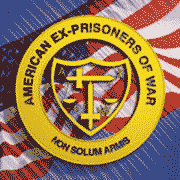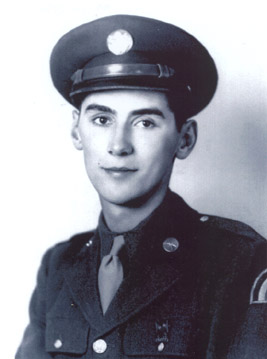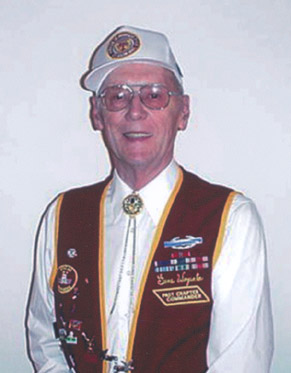
Established April 14, 1942
 |
American Ex-Prisoners of War
A not-for-profit, Congressionally-chartered veterans’ service organization advocating for former prisoners of war and their families.
Established April 14, 1942 |


Gene Wopata in uniform
|

Gene Wopata at AXPOW Convention
|
|
| Last Name | First Name, Middle Init. | Nickname |
| Street Add. | City | State |
| Zip | Spouse | |
| Conflict | Branch of Service | Unit: |
| Theatre of Operation | Military Job | Where Captured |
| Date Captured | Time Interned | Camps |
| Date Liberated | Medals Received | Age at Capture |
| After the War ... | ||
I took my basic training in Camp Wolters, TX. I joined the 42nd Rainbow Division in Camp Gruber, OK on October 24. We shipped out on the USS Gen. Wm. M. Black on November 25, and we landed in Marseille, France, on December 8. We went by truck to CP II to where we stayed a couple of weeks. We were sleeping in pup tents. Then came a crowded train ride from CP II to an area near Strasbourg, France.
The Germans second thrust of the Battle of the Bulge, called Nordwind, started the first week in January. The Germans crossed the Rhine River north of Strasbourg near Gambsheim, France.
On January 5, my Company suffered ten casualties. William Rosalie was killed, and Jack Weiser was wounded. They both were members of my squad. I carried Jack across the footbridge over the Zorn River so he could be moved to an aid station. That night Isadore Urban helped me dig my first and only foxhole in Europe. Digging was very difficult since the ground was frozen for several inches.
The next day our company continued toward the Steinwald Forest. After we captured a German outpost, they promptly shelled the area. I made a hasty exit from the timber to avoid the tree bursts. Machine gun fire from a tank, immediately pinned me down. I was finally wounded by artillery. Eventually the tank advanced and their infantry captured me. Six of us were captured near this tank.
We were taken across the railroad tracks where my wound was treated. We were then escorted to a building in Gambsheim where we were interrogated. (I visited this schoolhouse in 1985 and 1997.) The next day the Americans shelled us as we crossed the Rhine River on a barge type vessel. Then we were strafed by a P-47 as we hiked toward the Black Forest. I spent about two weeks in Stalag V A, near Ludwigsburg, Germany, where I was issued German dog tags. During my four-day train ride to Stalag IV B, my train was bombed in Frankfurt. This was a miserable train ride since it was cold, crowded, with very little food or water. Stalag IV B was near Muhlberg on the Elbe River 75 miles south of Berlin and 15 miles south of Torgau, Germany. (Torgau is where the Russians and Americans met on April 25, 1945) The prison camp was divided into ten compounds.
We were housed in wooden barracks. Our bunk beds were in groups of twelve. Three levels with four bunks on each level. There was a washroom in the middle of each barracks. This washroom had concrete walls and a concrete basin. Cold water was piped to the large basin so it could serve several people at a time. The water ran most of the time. I do not remember washing any clothes, since we wore everything we had to keep warm.
I remember taking a shower only a couple of times while I was a prisoner. We were herded into a large room where we undressed and hung our clothes on some portable racks. We then went into a shower room where the showerheads were in the ceiling. We had no control over the water flow, but it was warm and sure felt good. Apparently our clothes went through a gas chamber to kill the fleas, bedbugs, lice, etc. while we were showering. This was the delousing treatment. The clothes were not laundered. There were no towels. We dried ourselves by putting on our dirty clothes.
We received soup, a slice of bread and two small boiled potatoes a day. There were a lot of British prisoners in my compound. We were served tea twice a day. Three of us combined our food and cooked together. Our daily ration would not be equal, so when the three of us re-divided our meager ration each day, it provided us with a more stable daily ration. It also reduced the crowd at the stove. We would dice up the bread and potatoes add it with water to the "skillly" and end up with a cupful of soup twice a day. I lost 60lbs in less than four months on this diet.
The Russians liberated our camp on April 23, 1945. The Russians moved us from Stalag IV B on May 4. Some of us escaped from the Russians on May 9 and returned to American lines near Grimma, Germany. We went through Leipzig to Halle and then we were flown via a C-47 to Nancy, France. A train then took us to the RAMP Camp in Epinal.
We left Epinal on May 15 via a hospital train to Camp Lucky Strike. On June 4, we were trucked to LeHarve where we boarded the Admiral Benson. I saw the Statue of Liberty on June 12, 1945. Arrived home in DuBois, NE on June 17 (Father's Day).
After a sixty day convalescent furlough, I enjoyed a ten-day R & R in the Arlington Hotel in Hot Springs, Arkansas. Then several of us were sent to Fort Lawton, WA. I ended up being a company clerk of a Troop Train Detachment in Camp Jordan near Fort Lawton, WA. I was discharged on November 24, 1945 in Fort Lewis, WA.
I took advantage of the GI Bill and received a Mechanical Engineering Degree from the University of Nebraska in 1949. I worked for the Nebraska Highway Department before moving to Independence, MO. I then worked in the Sugar Creek Refinery for 30 years and retired in 1981.
My favorite hobbies are traveling, fishing and photography. My family did a lot of camping. I have been in all 50 States and most of the European countries and the Caribbean islands.
I have been the commander of the Heart of America Chapter and the Department of Missouri of the EX-POWs. I am also a life member of the DAV, VFW, American Legion, Purple Heart, and the 42nd Rainbow Division Veterans Association.
I met Evelyn Barr on a blind date in Omaha, and we were married in October 1951. We joined the First United Methodist Church in Independence, MO in 1952. We had three children, Steve, John and Susan.
Evelyn was a cancer victim in December 1996. Since then, I have found my second angel; I am now engaged to Yvonne Brice.